Keto Meal Plan Philippines (Free Printable 30-Day Meal Plan)

The keto diet has been gaining popularity as a quick and effective method of losing weight. You might have heard of it from your favorite fitness vlogger on Youtube, an influencer on Tiktok, or maybe co-workers who buy a lot of fat-burning supplements.
Whether you’re a first-timer intrigued by this popular diet or a keto fan looking for simple and affordable recipe ideas, this guide is for you.
Disclaimer: This article and the meal plan provided below are for educational and informational purposes only and are not intended to substitute medical advice. Dietary needs vary based on age, sex, height, weight, physical activity, and chronic illnesses. Before starting a keto diet, consult your physician and/or nutritionist-dietitian. He or she will most likely advise you to gradually incorporate more nutritious high-fat meals and less high-carb foods into your diet and drink lots of water.
Table of Contents
What Is a Keto Diet?
The ketogenic or “keto” diet is a low-carbohydrate, high-fat diet used for ages to treat various medical concerns. It was launched in 1920 3 as successful diet therapy for epileptic children who had failed to respond to medicines. The ketogenic diet has also been studied and utilized in cancer, diabetes, polycystic ovarian syndrome (PCOS), and Alzheimer’s4.
The low-carb diet trend that began in the 1970s with the Atkins diet5 paved the way for the popularity of the keto diet, which has become a commercial success and has been garnering significant interest as a viable weight-loss approach.
The idea behind the ketogenic diet for weight loss is simple. By depriving the body of glucose or the primary source of energy for all cells, an alternative fuel known as ketones is produced from stored fat, hence the term “keto”-genic.
Because it cannot store glucose, the brain requires the most glucose consistently. When only a small amount of carbohydrate is consumed, the body draws stored glucose from the liver and temporarily breaks down muscle to release glucose. If this continues for 3-4 days and the body’s stored glucose is wholly depleted, blood levels of insulin hormone fall, and it uses fat as its primary fuel.
Ketone bodies are produced by the liver from fat and may be utilized without glucose. This state of ketone production is referred to as ketosis6.
How Many Macros Should I Eat in Keto?
Subscribing to a keto diet helps you reach a state of nutritional ketosis, during which your body starts burning fat for fuel instead of glucose or carbohydrates.
Standard ketogenic diets recommend that an average of 70-80% of the total daily calories come from fats, 5-10% from carbohydrates, and 10-20% from protein7. A 2,000 daily calorie intake translates to 160-180 grams of fat, 20-50 grams of carbohydrates, and 50-100 grams of proteins. You should note that amino acids from your protein may be converted to glucose; therefore, you should only include enough protein to maintain lean body mass, including muscle, while still inducing ketosis.
Over time, your body adjusts to this new manner of converting energy and uses fat as a significant energy source. With that, you have reached a metabolic state where your body constantly utilizes fat!
How to Get Started With a Keto Diet (Free Sample 30-Day Meal Plan + Grocery List)
To give you an idea of what a month’s keto diet looks like, we have created a printable sample 30-day meal plan you can download for free! With this meal plan, you do not have to keep track of your carbohydrates. Each week includes a selection of keto foods to keep your daily net carbohydrates to 20-50 grams.
Download our free printable 30-day Keto meal plan for Filipinos
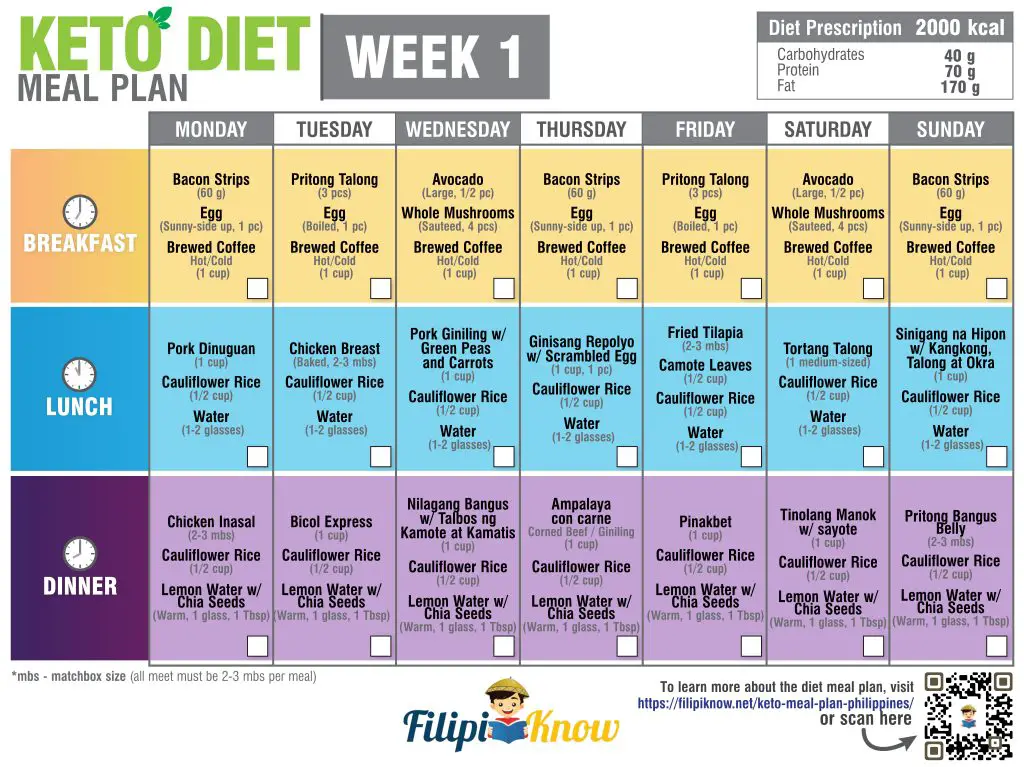
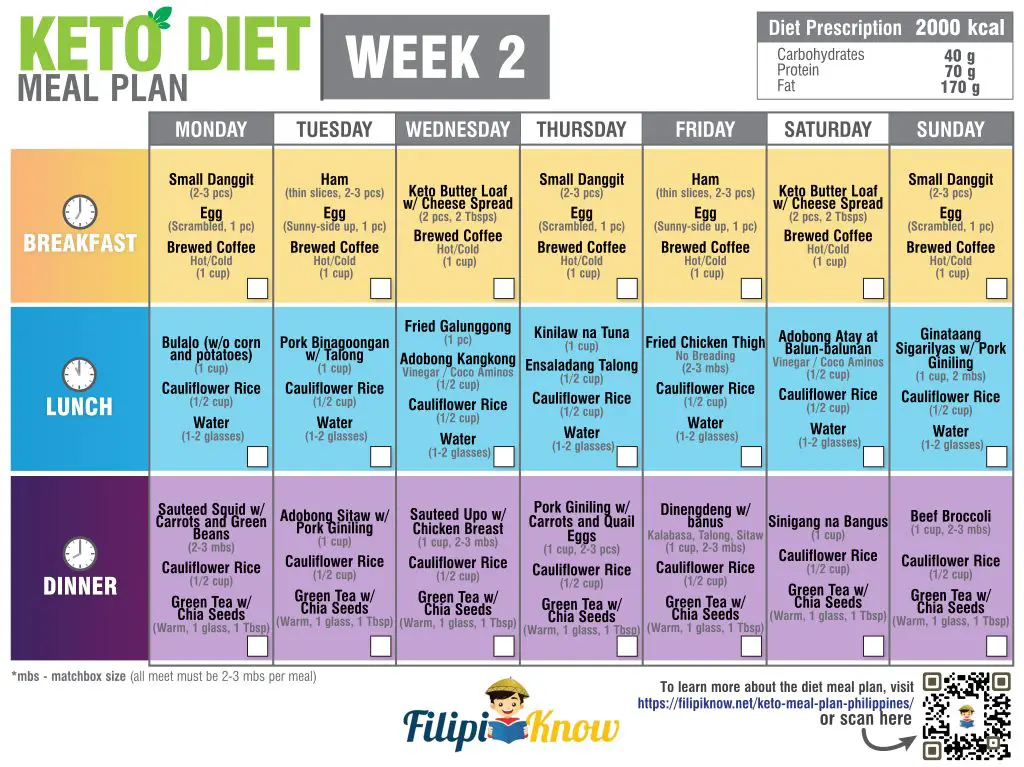

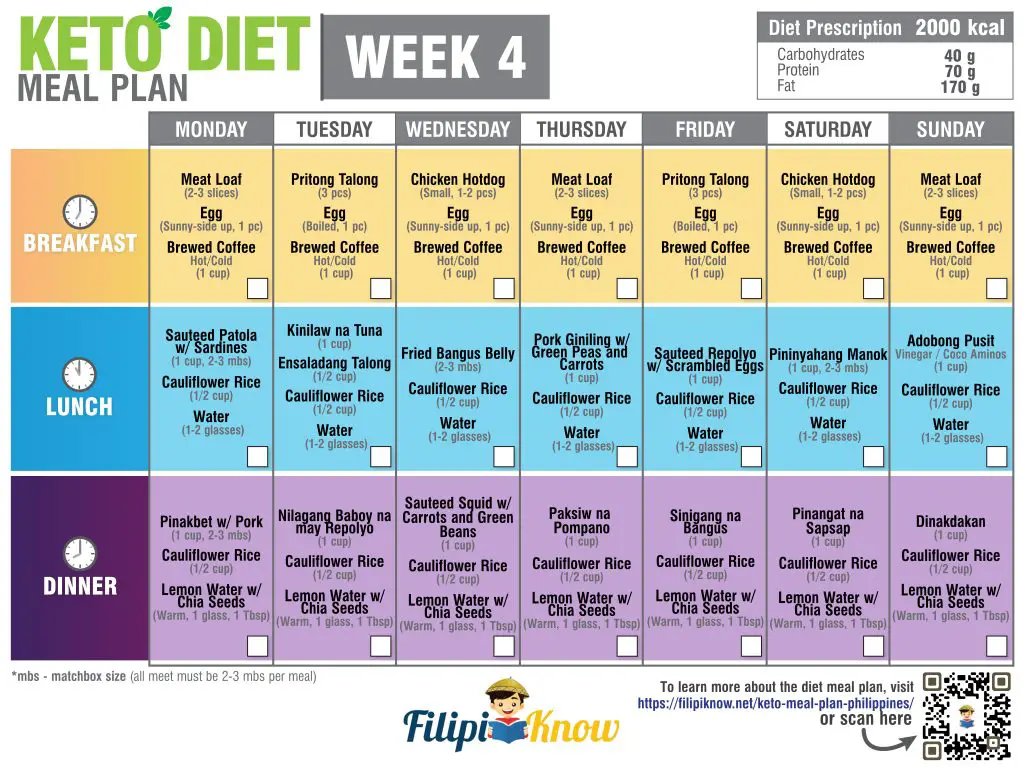
Click here to download the free 30-day Keto diet meal plan
Now that you know what a keto diet looks like, you need a list to start grocery shopping. Fortunately, we have also prepared a grocery list you can download and print for free, so you can buy all the ingredients you need for your keto diet meal plan.
Download our free 30-day Keto diet meal plan grocery list
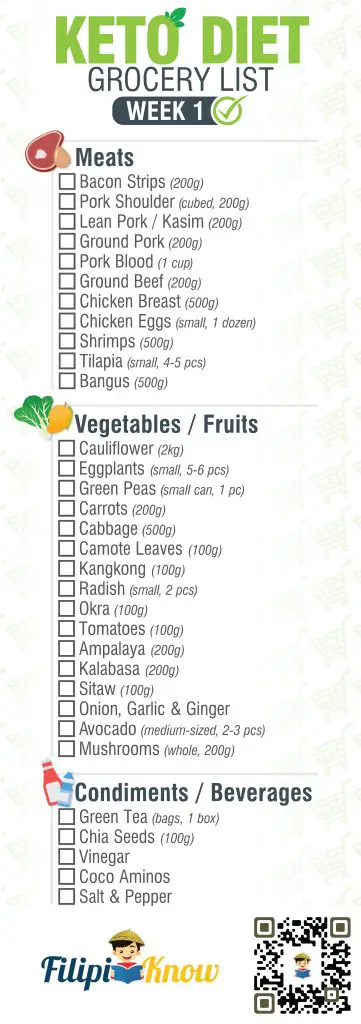
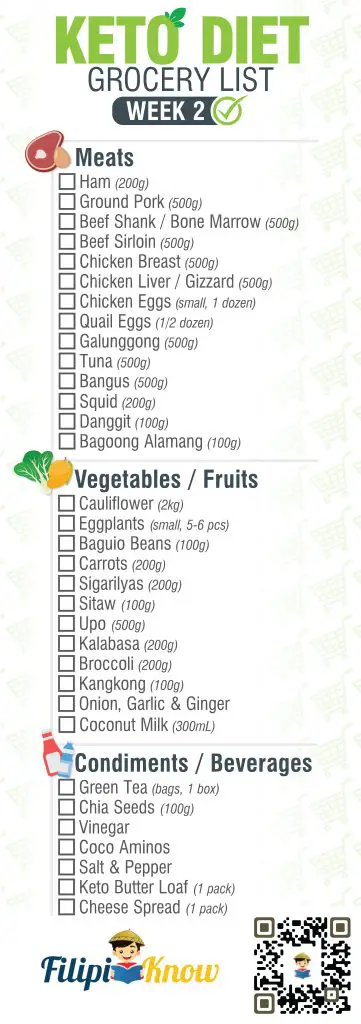
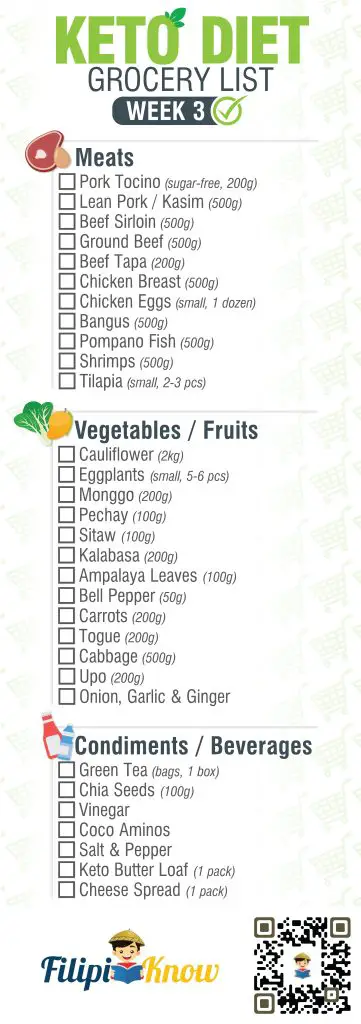
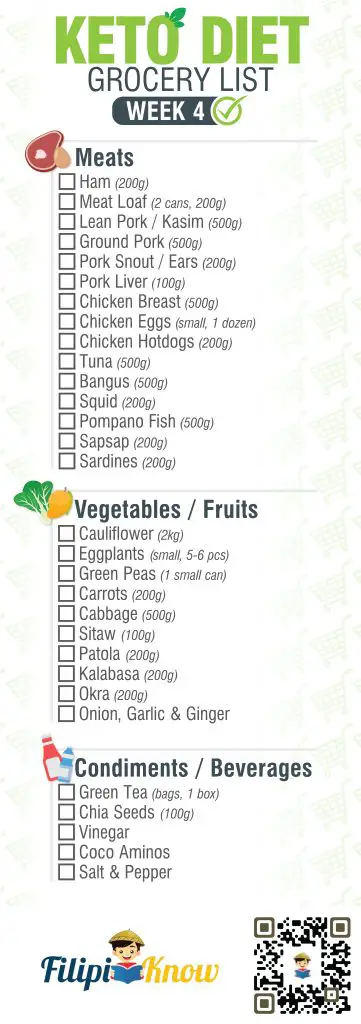
Click here to download the free 30-day Keto diet meal plan grocery list
Keto-Friendly Keto Dishes
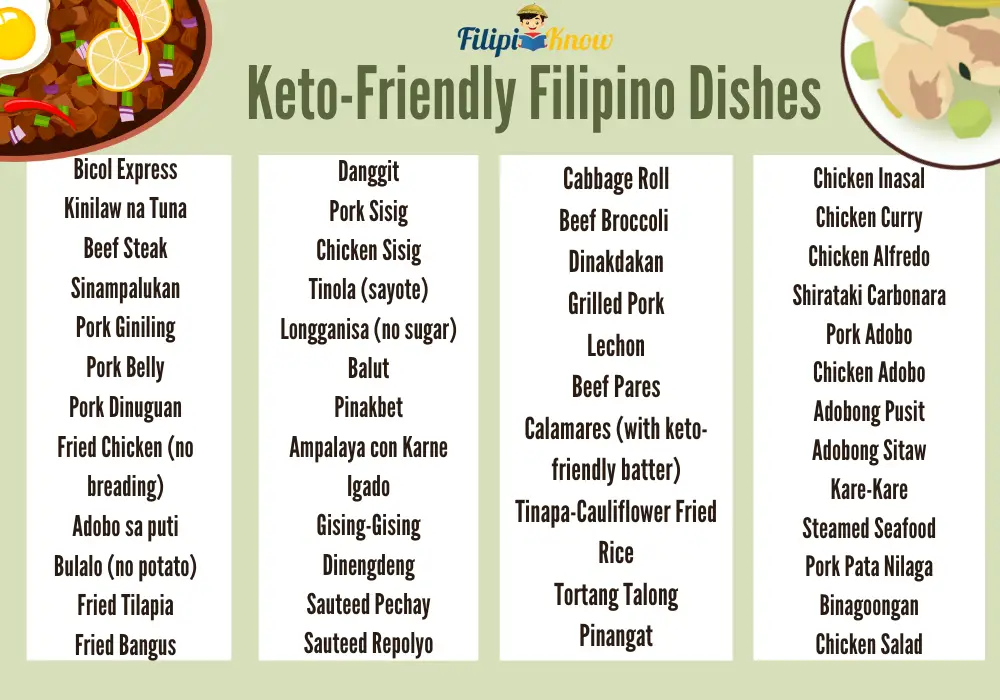
Keto Diet Foods in the Philippines
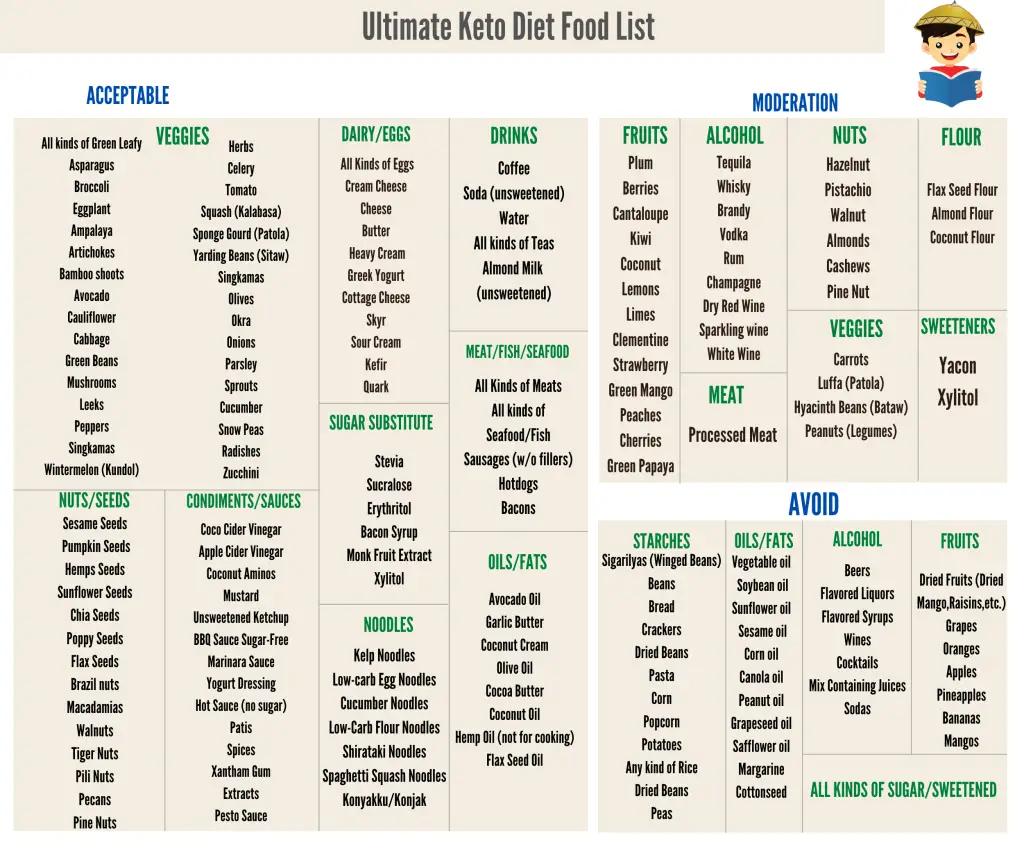
Health Benefits of the Keto Diet
The keto diet has been demonstrated to generate positive metabolic changes in research studies8. Along with weight loss, health markers related to excess weight, such as insulin resistance, high blood pressure, and high cholesterol and triglycerides, were shown to improve9. The studies led to the following conclusions:
- The high-fat content of the diet has a satiating effect that leads to decreased food cravings.
- A reduction in appetite-stimulating hormones such as insulin and ghrelin after consuming a low-carbohydrate diet.
- Ketone bodies—the body’s primary fuel source in the diet—directly reduce hunger sensations.
- Calorie consumption rises due to the metabolic impacts of converting fat and protein to glucose.
- Fat loss vs. lean body mass is encouraged, partially due to lower insulin levels.
Because the keto diet eliminates sugar and most carbohydrates, it is easy to see why it is also suitable for blood sugar control, particularly with diabetic patients10. The less sugar and carbs you consume, the less sugar in your bloodstream. This is why, almost immediately after beginning a keto diet, most people will notice a decrease in their blood sugar. The effects are so immediate that diabetics who begin a ketogenic diet should work with their healthcare provider to adjust their medication as needed as their glucose levels decrease and stabilize.
In addition, ketones are a natural neuroprotective antioxidant that has been shown to protect the brain from harmful reactive oxygen species11. Ketones have been shown to boost mitochondrial efficiency and production, which aids in the protection of brain cells from strokes and neurodegenerative diseases like Alzheimer’s and Parkinson’s. It also helps regulate glutamate (a dominant neurotransmitter in our brain), which, if overstimulated, can cause nerve cell damage.
Lastly, according to research12, a keto diet may benefit cancer therapy. Small human trials and research on mice show that the keto diet may have beneficial effects, including the following:
- Slows down tumor growth
- Protects healthy cells from the effects of chemotherapy or radiation therapy
- It helps anti-cancer drugs work faster or more effectively
- Reduces inflammation, which can promote cancer growth
- It helps prevent weight gain during and after breast cancer chemotherapy. Extra weight increases the likelihood of tumor recurrence.
However, because several human trials are ongoing, no major cancer organization recommends keto diets for cancer prevention or treatment.
Tips and Warnings
1. Start slowly
Instead of switching from high-carb to keto on the same day, start by eliminating foods rich in refined sugar like candies, pastries, and morning cereals and refined carbohydrates such as pasta, white rice, sweet treats, and bread from your diet. Finally, eliminate natural high-carb foods like potatoes, sweet potatoes, bananas, etc. This gives your body time to adjust to eating low-carb and helps you minimize the powerful initial cravings that usually occur when you suddenly stop feeding your body carbohydrates.
2. Do not be alarmed by the keto flu symptoms
Transitioning to the keto diet might cause symptoms13 such as headaches, irritability, sweet cravings, lethargy, stomach aches, and sleeping problems as your body adjusts to its new fuel source. These usually appear a few days after you achieve and maintain ketosis. The good news is that there are ways to manage these said symptoms:
a. Supplement your body with electrolytes by adding pink Himalayan sea salt to your drinking water14. A good choice for water is mineral or spring water, as it is an excellent source of electrolytes, particularly magnesium. Some will also drink bone broth throughout the day since it is rich in sodium and potassium.
b. If your sugar cravings are out of control, consuming extra fat is a good idea. Fat is the most satiating macronutrient, and it also helps your body produce ketones, suppressing appetite.
c. If the above strategies do not work, including a few starchy carbs in one of your daytime meals may be suitable. Bananas and sweet potatoes are good carb options in this scenario since they are high in minerals. Do this for a few days to see whether the keto flu symptoms subside, then gradually move to a strict keto diet.
3. Check how you are feeling
Pay attention to how you feel after a month of keto. Do you feel better than in your previous lifestyle? Or are you frequently depressed and exhausted? If you are still struggling with sticking to a keto diet after 1-2 months, consider altering your eating habits to match your lifestyle and eating patterns while improving your sense of wellness.
4. Your waist circumference and weight will fluctuate naturally from day to day
Monitoring these every 3-5 weeks will give you a more accurate picture of how well your diet benefits you. In other words, do not get too worked up if you haven’t lost any weight or inches after a week. Stick to your meal plan for at least three weeks before checking your progress and adjusting your diet.
5. Nutrient deficits may occur if the ketogenic diet does not contain a variety of healthy keto meals
It is critical to incorporate a daily variety of the allowed meats, fish, vegetables, fruits, nuts, and seeds to guarantee appropriate intakes of fiber, B vitamins, and minerals (iron, magnesium, zinc)—nutrients commonly present in foods such as whole grains that are excluded from the diet.
6. If you decide to start a ketogenic diet, it is best to consult with a physician and a dietitian
They will be able to closely monitor any biochemical changes after starting this diet and develop a meal plan designed for your existing health conditions to avoid nutritional deficiencies or other health complications.
Frequently Asked Questions
1. What is the main difference between low-carbohydrate and keto diets?
A low-carb diet limits carbohydrates, such as grains, rice, and starchy vegetables, to 10-30% of total calorie consumption, possibly resulting in weight loss. The keto diet, on the other hand, limits carbohydrates to 5-10% of your daily calories. This induces nutritional ketosis in your body, promoting the use of fat as a primary fuel source. While both diets cut carbohydrates to varying extents, the keto diet is more restrictive. For the majority, the low-carb diet is considered more sustainable in the long run.
2. Can I also practice intermittent fasting while on a keto diet?
Combining the keto diet with intermittent fasting may help you attain ketosis faster than the keto diet alone15. It might also lead to more fat loss. However, while this technique may work miracles for some, mixing both is not required, and other people should avoid this combination due to health risks16. You should see your doctor or a licensed nutritionist-dietitian if you intend to do both.
References
- Lichtash, C., Fung, J., Ostoich, K., & Ramos, M. (2020). Therapeutic use of intermittent fasting and ketogenic diet as an alternative treatment for type 2 diabetes in a normal weight woman: a 14-month case study. BMJ Case Reports, 13(7), e234223. doi: 10.1136/bcr-2019-234223
- Bradley, S., & Santilli, M. (2020). Can Combining Intermittent Fasting And Keto Help You Lose More Weight? Retrieved 24 August 2022, from https://www.womenshealthmag.com/weight-loss/a29247294/intermittent-fasting-keto-diet/
- Wheless, J. (2008). History of the ketogenic diet. Epilepsia, 49, 3-5. doi: 10.1111/j.1528-1167.2008.01821.x
- Paoli, A., Rubini, A., Volek, J., & Grimaldi, K. (2013). Beyond weight loss: a review of the therapeutic uses of very-low-carbohydrate (ketogenic) diets. European Journal Of Clinical Nutrition, 67(8), 789-796. doi: 10.1038/ejcn.2013.116
- Atkins Diet: What’s behind the claims?. (2022). Retrieved 24 August 2022, from https://www.mayoclinic.org/healthy-lifestyle/weight-loss/in-depth/atkins-diet/art-20048485#:~:text=The%20Atkins%20Diet%20is%20a,for%20weight%20loss%20and%20maintenance.
- Ketosis. Retrieved 24 August 2022, from https://www.webmd.com/diabetes/type-1-diabetes-guide/what-is-ketosis#1
- Mohan, V., & Shilpa, J. (2018). Ketogenic diets: Boon or bane? Indian Journal Of Medical Research, 148(3), 251. doi: 10.4103/ijmr.ijmr_1666_18
- Gershuni, V., Yan, S., & Medici, V. (2018). Nutritional Ketosis for Weight Management and Reversal of Metabolic Syndrome. Current Nutrition Reports, 7(3), 97-106. doi: 10.1007/s13668-018-0235-0
- Crosby, L., Davis, B., Joshi, S., Jardine, M., Paul, J., Neola, M., & Barnard, N. (2021). Ketogenic Diets and Chronic Disease: Weighing the Benefits Against the Risks. Frontiers In Nutrition, 8. doi: 10.3389/fnut.2021.702802
- Alarim, R., Alasmre, F., Alotaibi, H., Alshehri, M., & Hussain, S. (2020). Effects of the Ketogenic Diet on Glycemic Control in Diabetic Patients: Meta-Analysis of Clinical Trials. Cureus. doi: 10.7759/cureus.10796
- Tabaie, E., Reddy, A., & Brahmbhatt, H. (2021). A narrative review on the effects of a ketogenic diet on patients with Alzheimer’s disease. AIMS Public Health, 9(1), 185-193. doi: 10.3934/publichealth.2022014
- Tan-Shalaby, J. (2017). Ketogenic Diets and Cancer: Emerging Evidence. Pubmed Central. Retrieved from https://www.ncbi.nlm.nih.gov/pmc/articles/PMC6375425/
- Bostock, E., Kirkby, K., Taylor, B., & Hawrelak, J. (2020). Consumer Reports of “Keto Flu” Associated With the Ketogenic Diet. Frontiers In Nutrition, 7. doi: 10.3389/fnut.2020.00020
- Spritzler, RD, CDE, F., & Tamber, MD, D. (2022). Do You Need Electrolyte Supplementation on a Keto Diet? — Diet Doctor. Retrieved 24 August 2022, from https://www.dietdoctor.com/low-carb/keto/supplements
- Lichtash, C., Fung, J., Ostoich, K., & Ramos, M. (2020). Therapeutic use of intermittent fasting and ketogenic diet as an alternative treatment for type 2 diabetes in a normal weight woman: a 14-month case study. BMJ Case Reports, 13(7), e234223. doi: 10.1136/bcr-2019-234223
- Bradley, S., & Santilli, M. (2020). Can Combining Intermittent Fasting And Keto Help You Lose More Weight? Retrieved 24 August 2022, from https://www.womenshealthmag.com/weight-loss/a29247294/intermittent-fasting-keto-diet/
Bermonica Satuito, RND
Bermonica Satuito is a Registered Nutritionist-Dietitian (RND) who earned her degree from the University of the Philippines (UP) Los Baños. She is currently practicing in the medical aesthetics industry after working in research at WHO (World Health Organization) Philippines. Qualified and trained in educating individuals to achieve optimum well-being, she writes and creates content about health on various platforms. Youth leadership, community volunteering, SDGs, ASEAN, and entrepreneurship are among her interests.
Copyright Notice
All materials contained on this site are protected by the Republic of the Philippines copyright law and may not be reproduced, distributed, transmitted, displayed, published, or broadcast without the prior written permission of filipiknow.net or in the case of third party materials, the owner of that content. You may not alter or remove any trademark, copyright, or other notice from copies of the content. Be warned that we have already reported and helped terminate several websites and YouTube channels for blatantly stealing our content. If you wish to use filipiknow.net content for commercial purposes, such as for content syndication, etc., please contact us at legal(at)filipiknow(dot)net